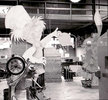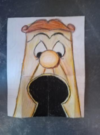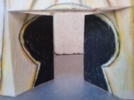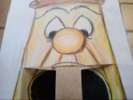Clover Bailey
Well-Known Member
Wow, it's so bizarre seeing a picture of old Fantasyland with it's medieval fair style while also being able to see Space Mountain in the background. Feels like they're from different eras, you know?In the late seventies, all the plywood flats in the Fantasyland dark rides were repainted with additional detailing and shading in an attempt to make them look a little less "crude"; this can also be observed in Mr. Toad and Snow White on the same 1980 Fantasyland souvenir film. In the case of the swing-down Cheshire Cat, however, the repainting only resulted in the flat looking more generic, as originally it appeared more or less like a silhouette, with very pronounced eyes and teeth against a dark head and body.
This very mild overhaul of the dark ride interiors kind of coincided with the new designs applied to Fantasyland's tournament tent facades around the same time. I don't know if many people are very aware of this, but the original, pre-redesign Fantasyland actually spent its last five or six years with a less tacky, less garish appearance overall, with slightly more muted colors adorning the facade canopies and realistic heraldic symbols replacing many of the original stripes and geometric patterns.
Also, was the giant cutout of the Mad Hatter pouring tea for the March Hare part of the late 70s repaint, or was that installed much earlier?





